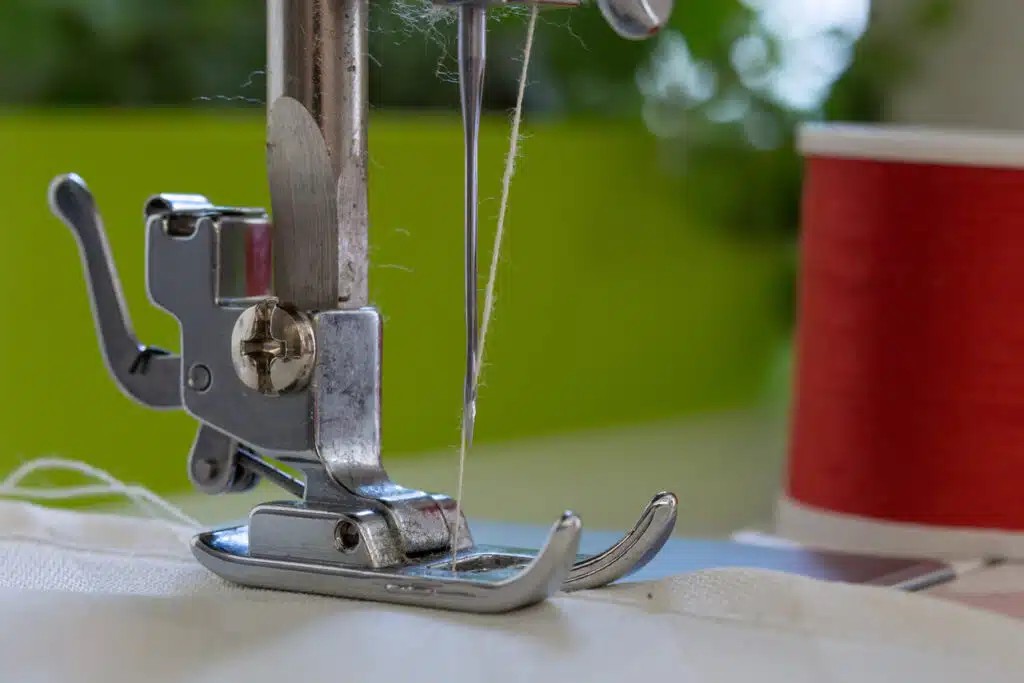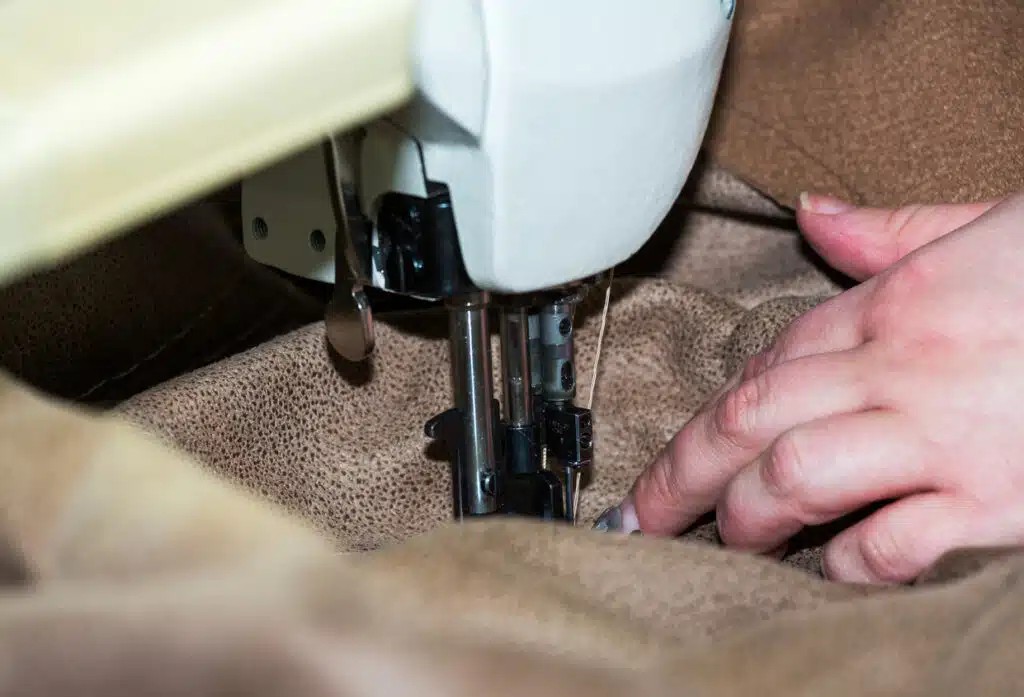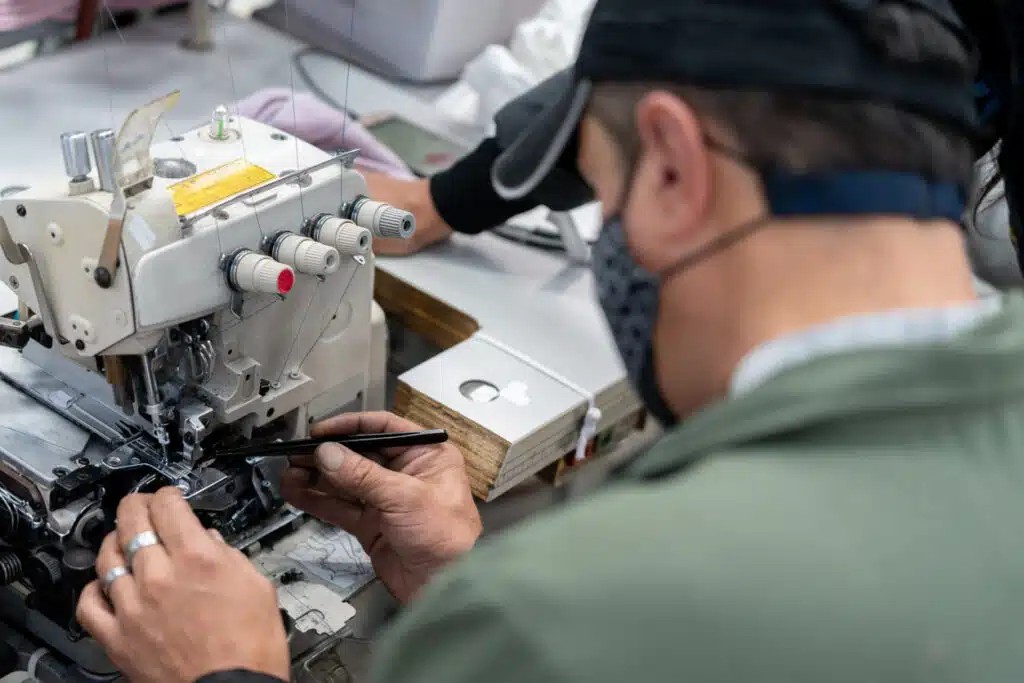Why Does My Sewing Machine Keep Jamming? It’s a frustrating question for sewists of all levels. At WHY.EDU.VN, we understand how disruptive a sewing machine jam can be, and we’re here to provide solutions. Discover the primary causes, from incorrect threading to dull needles, and learn how to troubleshoot and prevent future issues, ensuring smooth and enjoyable sewing sessions with sewing machine maintenance tips, sewing machine repair guide, and sewing machine troubleshooting guide.
1. Common Causes of Sewing Machine Jamming
If your needle stops moving, fabric won’t feed, threads bunch up, or the machine makes unusual sounds, a jam is likely. These jams aren’t catastrophic and usually stem from easily fixable issues. Regular maintenance is key to preventing future clogs. Frayed threads and fabric can accumulate inside the machine, causing build-up over time. Taking care of your machine prevents jams before they start. Ignoring jams can lead to lasting damage.
So, why does a sewing machine keep jamming? Here are some common culprits:
- Clogs in inner mechanisms
- Loose fabric tangling in the feeding process
- Improperly placed needles
Let’s examine these causes and their symptoms more closely.
2. Incorrect Thread Tension and Sewing Machine Jams
Incorrect thread tension can cause uneven pulling on the fabric by the upper and lower (bobbin) threads. If the tension is too tight, the fabric won’t feed properly, leading to jams or needle misalignment. Adjust the thread tension based on your fabric and thread type. Test on scrap fabric until you achieve the desired tension. Proper threading and regular cleaning also help prevent tension-related jams.
3. Thread Misplacement: A Source of Sewing Machine Frustration
Improper threading can cause the thread to snap during sewing. The broken thread can then entangle in the machine’s moving parts, leading to a jam. Removing tangled thread can be difficult, making proper threading essential. Consult your sewing machine’s manual for threading instructions, as each machine differs. Ensure the thread is correctly positioned through all guides, tension discs, and the needle’s eye.
4. Bobbin Issues and Their Role in Sewing Machine Jams
Like needle thread, the bobbin thread is a common cause of jams. Incorrectly wound bobbin thread or improper threading through the bobbin case can lead to uneven tension and thread bunching beneath the fabric. This interferes with the needle’s movement, causing a jam.
Here’s a quick guide to correctly threading the bobbin:
- Select a suitable bobbin and matching thread.
- Follow the threading path in your manual.
- Hold the bobbin and upper thread together and pull both under the presser foot.
- Close the bobbin case or slide plate securely.
5. The Impact of Dull or Bent Needles on Sewing Machine Performance
Sometimes, the issue isn’t internal. Check if the needle is dull or bent. Dull or bent needles can cause skipped stitches or fabric pulls, mimicking a jam. Replace the needle after each project to ensure it’s sharp and ready.
Replacing a sewing machine needle is simple:
- Turn off the machine.
- Raise the presser foot.
- Loosen the needle clamp or screw.
- Remove the old needle.
- Insert the new needle with the flat side facing the back (or as directed by your manual).
- Tighten the clamp securely.
- Lower the presser foot.
6. Fabric and Needle Mismatch: A Recipe for Sewing Machine Jams
Mismatching fabric and needle types is a common cause of jams. Needles are designed for specific fabrics. Using the wrong needle for a fabric can lead to problems.
Here are common needle types and their uses:
| Needle Type | Fabric Suitability |
|---|---|
| Universal Needles | Lightweight to medium-weight fabrics |
| Ballpoint Needles | Knit and stretch fabrics (jersey, spandex) |
| Sharp Needles | Lightweight and tightly woven fabrics (silk, microfiber, satin) |
| Jeans/Denim Needles | Heavy fabrics (denim, canvas, upholstery materials) |
| Embroidery Needles | Machine embroidery |
| Leather Needles | Leather, suede, vinyl, faux leather |
| Quilting Needles | Quilting and piecing quilt layers |
| Twin Needles | Decorative topstitching and hems |
| Serger Needles | Sergers |
| Metallic Needles | Metallic or specialty threads |
| Wing Needles | Decorative hemstitch effect |
| Topstitch Needles | Heavy topstitching threads |



Using a ballpoint needle on leather, for example, will likely cause jams.
7. Troubleshooting and Fixing Sewing Machine Jams: A Step-by-Step Guide
Don’t panic when your sewing machine jams. Here are some troubleshooting steps to get you back on track quickly.
8. Stop and Assess: The First Step in Resolving a Sewing Machine Jam
The first step is to stop the machine and assess the situation. Turn off the machine and look for visible clogs or bunches. If the needle is bent or broken, replace it. If the thread is snagged externally, cut the knots and re-thread the needle. For internal issues, remove the machine’s shell and check for snags and clogs.
9. How to Safely Remove Fabric and Thread from a Jammed Sewing Machine
Here’s how to safely remove tangled fabric and thread:
- Turn off and unplug the machine for safety.
- Raise the presser foot.
- Carefully cut tangled threads with small scissors.
- Remove the bobbin and any loose threads from the bobbin area.
- Gently pull and unwind the fabric from around the needle and other parts.
- Check for broken or bent needles and replace if needed.
- Examine the feed dogs for trapped threads or fabric.
- Clean the bobbin area and surrounding parts.
- Re-thread the machine following the manual’s instructions.
- Run a test stitch on scrap fabric.
Following these steps will help you effectively remove snags and clogs without damaging the machine.
10. Recognizing When Professional Help Is Needed for Sewing Machine Repair
Some jams are more serious. If the jam is due to loose thread or fabric, you can likely fix it yourself. However, if the issue involves internal components or damage occurs during repair attempts, seek professional help from a qualified technician. Look for local businesses with good reviews and recommendations from other sewists.
11. Preventing Future Sewing Machine Jams: Proactive Measures
Preventing future jams is key. Now that you understand the potential causes of a sewing machine jam, let’s review how you can keep those jams at bay and stay focused on your project.
12. Best Practices for Proper Sewing: Reduce Sewing Machine Jams
Proper sewing practices are the best way to avoid jams. Adhering to your machine’s manual, properly setting up your machine, and following general sewing guidelines can significantly reduce jams. Properly threading your machine, pairing the right fabrics with the right needles, and maintaining regular upkeep will extend the machine’s life.
13. Establishing a Regular Maintenance Schedule for Your Sewing Machine
Maintaining your sewing machine is essential for its longevity and your sewing results. Follow this maintenance schedule to keep your machine in prime condition.
| Frequency | Task |
|---|---|
| Daily | Clean the machine, replace the needle if necessary |
| Weekly | Thorough cleaning, wipe down exterior, oil the machine (if required) |
| Monthly | Double-check tension settings, inspect thread condition |
| Every 3-6 Months | Deep cleaning (disassemble bobbin case, needle plate, etc.) |
| Annually | Professional servicing |
Specific maintenance needs may vary based on your machine’s usage and type.
Sewing is a rewarding activity, but dealing with jams is not. By following best practices, properly threading needles, and regularly maintaining your machine, you can enjoy jam-free sewing. Keep an eye on loose threads and fabrics, and use the best needles for each project to extend your sewing machine’s life.
Do you find yourself constantly battling sewing machine jams? Are you tired of projects grinding to a halt because of tangled threads and frustrating malfunctions? At WHY.EDU.VN, we understand these challenges. Our mission is to provide you with the expert guidance and reliable information you need to keep your sewing machine running smoothly. Visit WHY.EDU.VN today, and let our community of experts help you master your machine and create with confidence. Contact us at 101 Curiosity Lane, Answer Town, CA 90210, United States. Whatsapp: +1 (213) 555-0101.
FAQ: Addressing Your Sewing Machine Jam Questions
Here are some frequently asked questions about sewing machine jams:
- Why does my sewing machine keep jamming when I sew thick fabrics? Sewing thick fabrics requires a stronger needle and higher tension settings. Ensure you’re using a needle designed for heavy materials like denim or leather. Adjust the tension accordingly and sew at a slower speed to prevent jams.
- Can the type of thread cause my sewing machine to jam? Yes, using low-quality or old thread can cause jams. Old thread can become brittle and break easily, while low-quality thread may produce excessive lint that clogs the machine’s mechanisms. Always use high-quality thread suitable for your fabric type and machine.
- How often should I clean my sewing machine to prevent jams? Ideally, clean your sewing machine after each project or at least once a month, depending on usage. Regular cleaning removes lint, dust, and thread remnants that can accumulate and cause jams.
- What are the signs that my sewing machine needle needs to be replaced? Signs include skipped stitches, snagged fabric, a dull or bent needle, and thread breakage. Replace the needle immediately if you notice any of these issues to prevent jams and ensure optimal stitching.
- Is it normal for my sewing machine to make noise before it jams? Unusual noises such as clicking, grinding, or clunking can indicate a problem within the machine. Stop sewing immediately, turn off the machine, and inspect it for any visible issues or obstructions. If the noise persists after cleaning and troubleshooting, seek professional assistance.
- Why does my bobbin keep getting tangled, leading to jams? A tangled bobbin can result from improper threading, incorrect bobbin winding, or a damaged bobbin case. Ensure the bobbin is correctly threaded and wound evenly. Inspect the bobbin case for any damage and replace it if necessary.
- How can I adjust the thread tension to prevent sewing machine jams? Refer to your sewing machine’s manual for guidance on adjusting thread tension. Test different tension settings on a scrap of fabric until you achieve balanced stitches. The top and bottom threads should meet evenly in the middle of the fabric.
- What tools do I need to troubleshoot and fix sewing machine jams? Essential tools include small scissors or snips, tweezers, a lint brush, a screwdriver, and your sewing machine’s manual. These tools will help you remove tangled threads, clean the machine, and make necessary adjustments.
- Can using the wrong presser foot cause my sewing machine to jam? Yes, using the wrong presser foot can affect fabric feeding and stitch quality, potentially leading to jams. Ensure you’re using the appropriate presser foot for your fabric type and sewing technique.
- When should I consider taking my sewing machine for professional servicing? If you’ve tried troubleshooting and cleaning your sewing machine but continue to experience jams or other issues, it’s time to seek professional servicing. A qualified technician can diagnose and repair complex mechanical problems that may be beyond your expertise.
Navigating the world of sewing machine maintenance and troubleshooting can be challenging. At WHY.EDU.VN, we’re dedicated to simplifying the process, providing you with clear, expert-backed answers to all your sewing-related questions. Don’t let sewing machine jams disrupt your creative flow any longer. Visit why.edu.vn today, and let our team of experts guide you toward a smoother, more enjoyable sewing experience. Our address is 101 Curiosity Lane, Answer Town, CA 90210, United States. You can also reach us via Whatsapp: +1 (213) 555-0101.